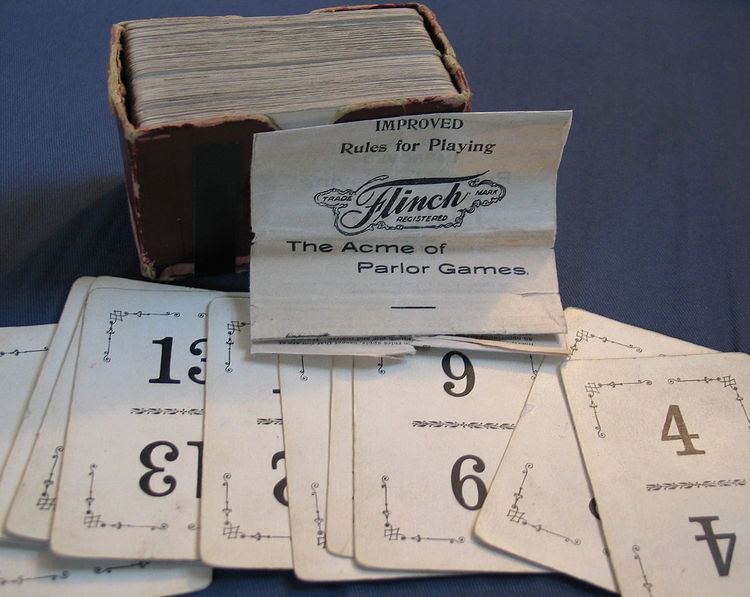Flinch is a card game that was invented in 1901 by A.J. Patterson.
Patterson grew up on a farm in Eaton County, Michigan, and graduated high school at the age of sixteen. He moved from job to job in Grand Rapids and Chicago before he finally settled in Kalamazoo, Michigan as a bookkeeper at a stationery store, Beecher & Kymer. [1]
At home one day while he was playing cards, he came up with the idea for Flinch. He decided to create the game and the deck. Later, he ran the Flinch Card Company out of the stationery store, that was renamed Beecher, Kymer, & Patterson. [2]
Flinch is a card game that is based on stockpiling. The game is played with a custom deck and was first produced by the Flinch Card Company in Kalamazoo. This custom deck has 150 cards: ten sets of cards numbered from one to fifteen. Some variations use a deck that has 144 cards. Flinch is based on another game called "Spite and Malice".
Although it is not as popular today as it was when it was originally released, Flinch decks are still available online and in stores. Websites such as Amazon, Yahoo, and The Find all offer different versions of the deck. Some decks are vintage, from the original printing in 1901 and are being sold for around $40.00 while others are from re-prints or copies. These versions can sell anywhere from $4.00 up to $15.00.
The object of the game is to get rid of all one's cards. This game can be played with any amount of players. Two to eight is the suggested amount of players, but to play with more than eight people, combine two decks of Flinch cards. The dealer deals each player 10 cards face down, which is their Flinch Pile. Next the dealer deals each player five more cards, but these cards are hand cards and are picked up and looked at by the players. The rest of the cards are dealt out in groups of five. These groups become the Stack.
The first player turns over the top card of his Flinch Pile and if it is a one, it gets placed in the middle of the table. If it is not a one, it is placed face up so all of the players can see it. The second player then turns over his top card, and repeats the process. This continues until all of the players have turned over their top cards.
The first player goes again, and if his face-up card happens to be a two it can be placed in the middle, on top of the one. If the top card cannot be played, the player plays from his hand (he is required to play 1s from his hand). If he can't play from his hand he may play from his reserve piles (but is not required to). Players must always play from the Flinch Pile first (and must play the card if possible). A player is not required to play from his Hand or Reserve Pile (except 1s as noted above).
Note that cards may be placed in the middle only in ascending order, starting at one and continuing to fifteen.
If the current player's Flinch Pile card can be played, but the player fails to do so, other players may yell "Flinch!". The person who catches the misplay then gives the player a card to be placed at the bottom of his Flinch Pile. The player's turn ends.
The person who empties his Flinch Pile first is the winner.

